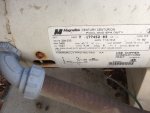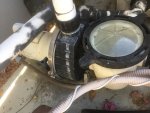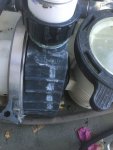My pump is leaking at top of the volute band clamp. I learned that word "volute" from the pump manual I found online. The motor label is clear. At 11 amps and 220V I conclude it is a 3HP motor. When was it made? The numbers V38-130 are molded into the pump housing. A google search shows this matches the volute for a Pentair Ultra-Flow pump. Are their some additional markings I should look for? If there are none, how do I determine what size impeller I have? I could just assume it is a 3HP impeller to match the motor.
My pump is leaking. Have I guessed the right pump manufacture and model?
- Thread starter justeastofapple
- Start date
You are using an out of date browser. It may not display this or other websites correctly.
You should upgrade or use an alternative browser.
You should upgrade or use an alternative browser.
That is a American Ultra Flo pump, which was discontinued many years ago. The volute on there is from a aftermarket manufacturer. The only real way to check impeller is to remove pump from the housing and look for any numbers on it. That seems way to much pump for a 15000 gallon pool, unless it is also used to run different features. In the long run when and if you can afford a variable speed pump that would be the way to go
- May 3, 2007
- 16,842
- Pool Size
- 20000
- Surface
- Plaster
- Chlorine
- Salt Water Generator
- SWG Type
- Hayward Aqua Rite (T-15)
When the HP and SF are --. That usually means both are 1. So I believe you have a 1 THP motor.
That pump uses about 2,346 watts. That's a lot of power.
The motor was made in June 2000. So, it's 20 years old.
Definitely time to replace it with a variable speed pump.
Do you need high flow for some reason?
What is your cost per kwhr?
How long do you run the pump per day?
The motor was made in June 2000. So, it's 20 years old.
Definitely time to replace it with a variable speed pump.
Do you need high flow for some reason?
What is your cost per kwhr?
How long do you run the pump per day?
Last edited:
- May 3, 2007
- 16,842
- Pool Size
- 20000
- Surface
- Plaster
- Chlorine
- Salt Water Generator
- SWG Type
- Hayward Aqua Rite (T-15)
Looked up the number and it appears to be a 2 HP:
Thanks kadavis. I really appreciate the information. We got the pump with the pool and the house nearly 2 years ago. I like to keep things a long time. I'm on my third car in 40 years. I think I need to change from a Polaris 360 to a robot before I change to a variable speed pump.That is a American Ultra Flo pump, which was discontinued many years ago. The volute on there is from a aftermarket manufacturer. The only real way to check impeller is to remove pump from the housing and look for any numbers on it. That seems way to much pump for a 15000 gallon pool, unless it is also used to run different features. In the long run when and if you can afford a variable speed pump that would be the way to go
Thanks for the info. I read about SF and motor ratings but I found it confusing so I will need to read it again.When the HP and SF are --. That usually means both are 1. So I believe you have a 1 THP motor.
The previous owner said he ran the pump 1 hour per day. That is what I have programmed but I sometimes turn it on to mix the chlorine or "clean up" after the pool has been used.That pump uses about 2,346 watts. That's a lot of power.
The motor was made in June 2000. So, it's 20 years old.
Definitely time to replace it with a variable speed pump.
Do you need high flow for some reason?
What is your cost per kwhr?
How long do you run the pump per day?
We pay 10 and 12 cents per KWH. (two tier billing). I think that is low for California. (city owned power system).
I need high flow for the spa but especially for the Polaris 360 cleaner. (no booster pump).
Thanks. I'm learning a lot about pools and pool equipment.Looked up the number and it appears to be a 2 HP:
If you can afford it, just get a variable speed pump and a robot.
I wouldn't put any money into fixing that old pump.
I wouldn't put any money into fixing that old pump.
I read lots of old threads so I am adding what I found as information for others in the future who do the same. When I asked my wife about getting a robot and a new variable speed pump instead of buying a new Volute for $100 (the labor, me, is free) she chose the $100 part. The volute is cracked along the top of the sealing flange. I am convinced that this area cracked because the motor is not supported in the middle. The cantilevered stress adds to the water pressure stress to cause the top of the volute to fail. I also measured the current, watts and volt-amps of the pump. It measured 2264W or just over 3HP. I got the part number of the impeller which was 390053. From what I can find, that should be a 2HP impeller and I don't understand the difference between the measured power and the impeller description. I could mention that I used the Kill A Watt to measure the current and power. I have a 230V pump and the Kill A Watt is designed for 120V. Don't do this at home. I connected one of the hot lines to the neutral line of the Kill A Watt and connected the hot line of the Kill A Watt to neutral. I left ground to the Kill A Watt disconnected and treated the entire Kill A Watt as a potential shock hazard.Thanks. I'm learning a lot about pools and pool equipment.
I did the same thing with a Kill-a-Watt and fried it. It was easy to fix.
I also don't recommend that anyone try it. I did it, but I knew the risk.
The hp rating of the pump is the delivered hp, and not the measured power.
The hp rating of the pump is usually the actual power used divided by about 1,000.
So the motor rating is about 2.2 to 2.6 hp.
In my opinion, I think that the better choice is to replace the pump.
I suspect that the fix is not going to go quite as smoothly as you are expecting.
Let us know how the fix goes.
Note: If the motor has a run capacitor, the power factor should be relatively close to one and the actual power should be close to the volt-amps.
I also don't recommend that anyone try it. I did it, but I knew the risk.
The hp rating of the pump is the delivered hp, and not the measured power.
The hp rating of the pump is usually the actual power used divided by about 1,000.
So the motor rating is about 2.2 to 2.6 hp.
In my opinion, I think that the better choice is to replace the pump.
I suspect that the fix is not going to go quite as smoothly as you are expecting.
Let us know how the fix goes.
Note: If the motor has a run capacitor, the power factor should be relatively close to one and the actual power should be close to the volt-amps.
Last edited:
I was surprised that the power factor was pretty good. I hadn't thought about the motor having a run capacitor but that makes sense. When I first connected the Kill-A-Watt, I didn't measure any current. I didn't realize that the Kill-A-Watt measures current in the neutral line and not in the "hot" line. Since the Kill-A-Watt is only seeing half the voltage, the current is correctly displayed but the voltage, watts, and volt-amps all need to be multiplied by two. Here is what I measured:
Normal pool mode but with Polaris 360 not connected:
Voltage:114.7V
Current:9.92A
Power: 1132 displayed Actual 2264 = 3.04HP
VA: 1141VA displayed Actual 2282
60.0 Hz
With no water in the pump:
2.43A
202W displayed 404 actual
294VA displayed 588VA actual
Normal pool mode but with Polaris 360 not connected:
Voltage:114.7V
Current:9.92A
Power: 1132 displayed Actual 2264 = 3.04HP
VA: 1141VA displayed Actual 2282
60.0 Hz
With no water in the pump:
2.43A
202W displayed 404 actual
294VA displayed 588VA actual
The Kill-a-Watt should be reading the actual voltage and wattage
If the supply voltage is 230, why would it show 115?
If the supply voltage is 230, why would it show 115?
I connected one phase of the supply voltage to the neutral input of the Kill-A-Watt. I connected the neutral output of the Kill-A-Watt to the pump. I connected the "hot" input of the Kill-A-Watt to neutral. The Kill-A-Watt is designed to measure voltages near 115V. It never occurred to me to see if it could measure voltages near 230V. For my measurements, I checked with a voltmeter to verify that the voltage of the two phases were fairly equal. It seems like we are discussing a lot of details for something we both agree most people should not attempt to do.
OK. I received a new volute and when I tried to install it, I discovered that someone has glued the diffuser to the old volute. Now I need to order a new diffuser and o-ring. I hope this ends here. A new pump is sounding better all the time.
Ok, a 20 year old pump is rarely worth fixing as you're finding out.
I would go with a new pump.
Let us know how it goes.
I would go with a new pump.
Let us know how it goes.
Happy 4th! The diffuser O-ring arrived yesterday evening. The pump is reassembled and not leaking. Yea! This gives me some time to research what pump I should get when this one fails again. I spent about $130 for parts and non-expedited shipping for the new volute, new diffuser, and new diffuser o-ring. I disassembled and reassembled the pump 3 times. I had to use a hot wrench (torch) to remove the set screw that was fastening the bond wire to the motor. If I ever need to disassemble the motor, the rusted bolts will most certainly break. After disassembling the pump the first time, I found that the water leak was not affecting the motor so continued using the pump until the new parts arrived. In hind site, what I experienced is pretty obvious. It is harder to find parts for older equipment. I found that cross reference lists were helpful in purchasing o-rings. I found that the suppliers that had the best prices didn't have all the parts I needed. I found that the same o-ring can vary in price from $2.50 to $15.00 My next pool project will be repairing lots of 2x2 tiles that are falling off my spill-over spa wall. I will likely start a new thread for that. I may also post photos of the wall I built to keep my Polaris cleaner from getting stuck on the stairs.
Thread Status
Hello , This thread has been inactive for over 60 days. New postings here are unlikely to be seen or responded to by other members. For better visibility, consider Starting A New Thread.
Similar threads
- Replies
- 4
- Views
- 158
- Replies
- 6
- Views
- 312
- Replies
- 17
- Views
- 404
- Replies
- 6
- Views
- 292




